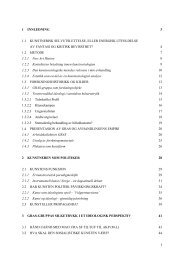2003 Rogaland museum - Gras Katalog - Victor Lind
2003 Rogaland museum - Gras Katalog - Victor Lind
2003 Rogaland museum - Gras Katalog - Victor Lind
Create successful ePaper yourself
Turn your PDF publications into a flip-book with our unique Google optimized e-Paper software.
A notion of GRAS<br />
Summary<br />
The production of GRAS in a historical light must be viewed both with regards to<br />
the artistic atmosphere that permeated the Norwegian artistic scene in the late 1960s<br />
and the early 1970s and with regards to the socio-political situation that was then<br />
dominant in the society as a whole.<br />
The production of GRAS can be regarded as in opposition to the nonfigurative<br />
image that was prominent in Norway in the 1960s. Accepting that the<br />
dominant aesthetic taste of the period emphasised the non-figurative form, the<br />
movement by GRAS to draw on other inspirations and artistic formulations was as<br />
significant as their political sympathies and aspirations. Those sympathies and<br />
aspirations took hold in their work through both subject matter and the intentions<br />
from which their creative acts grew.<br />
For the GRAS artists, the work of art as a physical entity represented more<br />
than just an interest in form, void of a possible relationship with its contemporary<br />
public. The work of art according to GRAS demanded that the beholder and the<br />
public took a stance to its import and the conditions concerning its existence. The<br />
inexpensive production of works of art, assisted by the silkscreen technique, was for<br />
example a politicised act in itself. As such, GRAS works were not simply politicised<br />
through the preferred subject matter. Since the group also attempted to tear down<br />
the division between high and low art, a division that was against their political<br />
views, the group intentionally created art for the people and not specifically for the<br />
economically fortunate few.<br />
What is interesting with regards to GRAS' production, however, is that they<br />
managed to unite the political and the aesthetic in their works, hailing their aestheticised<br />
argument in both individual works and group productions, as they attended<br />
to the roots of the social situation in Norway of the 1970s.<br />
13



